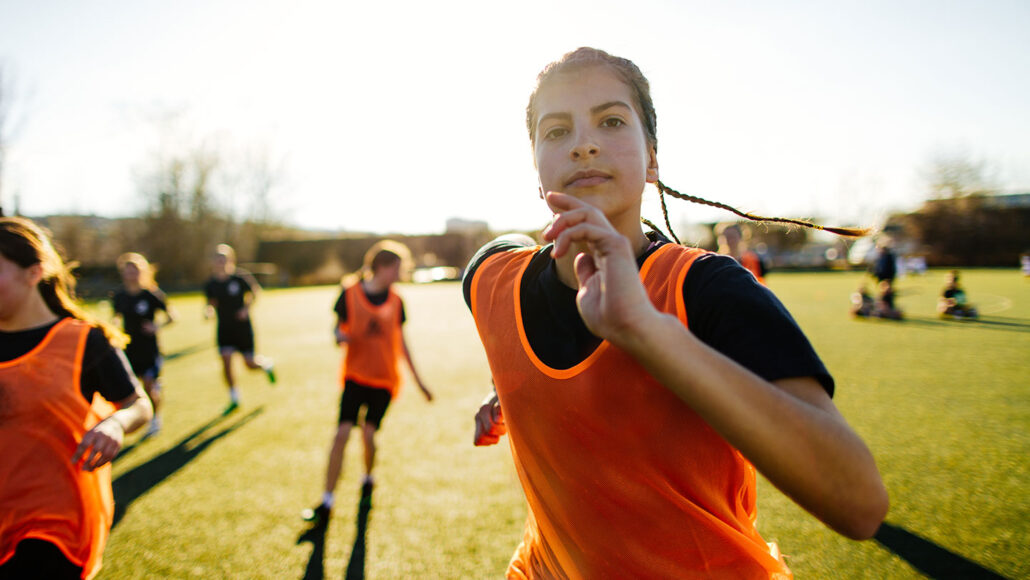Strongest bones come from Goldilocks recipe of exercise and rest
The right mix of these in our preteen years may be key to healthy bones throughout life

Physical activities that include running and jumping are important for building strong bones.
AleksandarNakic/E+/Getty Images
Adults develop most of their bone strength by age 20. So one gauge of how healthy our bones will be as adults is how much strength we build into them while we’re kids, notes Dot Dumuid. She studies physical activity and bone health at the University of South Australia in Adelaide. Her team’s new research now suggests what the ideal mix of activities and rest is during adolescence to build strong bones for your adult years.
The scientists describe it in terms of what they call a Goldilocks day. It has not too much of one thing or another. Instead, it focuses on just the right mix of sleep and various types of exercise. Unfortunately, the recipe they found for this day does not match up with what most adolescents get, starting with 11 hours of sleep.
Made of blood vessels and more, bone is living tissue. And it is “shaped by the force [the push or pull] that it experiences,” explains Leigh Gabel. She studies bone biology at the University of Calgary in Canada. Too much push or pull can cause a bone to break. But the right amount, she notes, can thicken bones and strengthen them.
Running and jumping, for instance, help build bone. And, Gabel adds, early to mid-puberty is when physical activity can really have an impact on the strength and size of bones.
But exercise isn’t all that’s needed. So is the down time necessary for growth and repair of tissues. That’s why Dumuid focused on finding the ideal mix of sleep, sitting time, light exercise and moderate-to-vigorous exercise. Light exercise might include walking or standing. More vigorous activities make you breathe harder. These might include bicycling, playing basketball, doing gymnastics or even quickly walking up a flight of stairs.
In a new study of roughly 800 kids, those with stronger bones had engaged in a mix of sleep and activity that came most closely to the Goldilocks mix.
Dumuid and her team shared their findings on September 23 in the Journal of Bone and Mineral Research.
Sleep matters
The researchers recruited kids in Australia between the ages 11 and 13 to take part in the study. Each kid wore a tracking device. Called an accelerometer (Ak-sel-ur-AHM-eh-tur), it uses an electric sensor to measures changes in motion. The students wore it 24/7 for eight straight days to chart their activities. They also wrote down what time they went to bed and woke up.
Then the researchers scanned each kid’s shin bones using an X-ray technique called computed tomography. These scans helped the researchers calculate the bones’ strength — how well they would resist bending. “If you bend a stick, how much force can you put on it before it snaps? That’s bone strength,” explains Dumuid.
The Goldilocks day for bone health in these students, her team found, includes 11 hours of sleep, no more than 8 hours of sitting, 3.5 hours of light exercise and 90 minutes of more vigorous activity.
“We were surprised to see how important sleep appeared to be for bone health,” says Dumuid. She says there seems to be “an important balance between being active and getting enough sleep.”
And during sleep, hormones in the body have time to use the vitamins and minerals needed for bone-building, the researchers now suspect.
Boys appeared to need more sleep to build strong bones than did girls. The Goldilocks recipe for boys included 2.4 hours more sleep than for girls. Then again, Dumuid notes, that may just be due to differences in the timing between boys and girls for key steps in puberty. Boys typically go through puberty a little later than girls. So boys in this study may still have been at an earlier stage. “Kids need more sleep during these early stages when there are a lot of hormonal changes going on,” she explains.
Though the researchers did not study older teens, Dumuid suspects that some parts of her team’s research will apply to them, too. They would likely need at least as much exercise, she says. But they might need less sleep because many of those hormonal processes in early puberty have already occurred.
Future studies should look at bone health in such kids over a longer span of time, says Gabel. Such studies could help researchers better understand how activity levels in childhood might relate to when and how osteoporosis plays out in adults.
What can you do to build stronger bones now? Dumuid says most kids in the study got far less than 90 minutes of moderate to vigorous physical activity each day. She urges kids to look for small ways to up their exercise. “Take the stairs. Run to the bus stop. Or try standing at your computer,” she says, “rather than sitting.”







